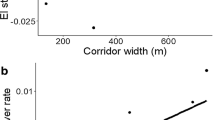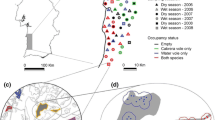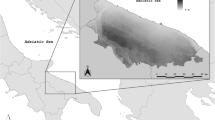Abstract
We tested the effects of increased landscape corridor width and corridor presence on the population dynamics and home range use of the meadow vole (Microtus pennsylvanicus) within a small-scale fragmented landscape. Our objective was to observe how populations behaved in patchy landscapes where the animals home range exceeded or equaled patch size. We used a small-scale replicated experiment consisting of three sets of two patches each, unconnected or interconnected by 1-m or 5-m wide-corridors, established in an old-field community (S.W. Ohio). Control (0-m) treatments supported significantly lower vole densities than either corridor treatment. Females were the dominant resident sex establishing smaller home ranges (<150m2) than males (>450m2). Significantly more male voles dispersed between patches with corridors than between patches without corridors. However, no difference was observed regarding the number of male voles dispersing between patches connected by corridors when compared to the number dispersing across treatments. Dispersal between connected patches was restricted to corridors based on tracking tube data. Corridor presence was more important than corridor width regarding the movement of male voles within their home range.
Similar content being viewed by others
References
Batzli, G.O., Getz, L.L. and Hurley, S.S. 1977. Suppression of growth and reproduction of microtine rodents by social factors. J. Mammal. 58: 583–591.
Berg, H.C. 1983. Random Walks in Biology. Princeton University Press, Princeton, NJ.
Birney, E.C., Grant, W.E. and Baird, D.D. 1976. Importance of vegetative cover to cycles of Microtus populations. Ecology 57: 1043–1051.
Bollinger, E.K., Harper, S.J., Kramer, J.M. and Barrett, G.W. 1991. Avoidance of inbreeding in the meadow vole (Microtus pennsylvanicus). J. Mammal. 72: 419–421.
Buechner, M. 1987. Conservation in insular parks: Simulation models of factors affecting the movement of animals across park boundaries. Biol. Conserv. 41: 57–76.
Buechner, M. 1989. Are small-scale landscape features important factors for field studies of small mammal dispersal sinks? Landscape Ecology 2: 161–199.
Cole, F.R. 1978. A movement barrier useful in population studies of small mammals. Am. Midl. Nat. 100: 480–482.
Emlen, S.T. and Oring, L.W. 1977. Ecology, sex selection and the evolution of mating systems. Science 197: 215–223.
Fahrig, L. and Merriam, G. 1985. Habitat patch connectivity and population survival. Ecology 66: 1762–1768.
Forman, R.T.T. and Godron, M. 1986. Animal and plant movement across a landscape. In Landscape Ecology, pp. 357–395. Edited by R.T.T. Forman and M. Godron. John Wiley and Sons, New York.
Getz, L.L. 1960. A population study of the vole, Microtus pennsylvanicus. Am. Midl. Nat. 64: 392–405.
Getz, L.L. 1985. Habitats. In Biology of New World Microtus. pp. 286–305. Edited by R.H. Tamarin. Am. Soc. Mammalogists Spec. Publ. No. 8.
Getz, L.L., Cole, F.R. and Gates, D.L. 1978. Use of interstate roadways as dispersal routes by Microtus pennsylvanicus. J. Mammal. 50: 208–212.
Harper, S.J. 1990. Effects of patch shape on the dispersal behavior and population dynamics of the meadow vole (Microtus pennsylvanicus). M.S. thesis. Miami University, Oxford, OH, U.S.A.
Harris, L.D. 1985. Conservation corridors: A highway system for wildlife. ENFO report 85–5. Fla. Cons. Found., Winter Park, Florida.
Harris, L.D. and Gallagher, P.B. 1989. New initiatives for wildlife conservation: The need for movement corridors. In In Defense of Wildlife: Preserving Communities and Corridors. pp. 11–34. Edited by G. Mackintosh. Defenders of Wildlife, Washington D.C.
Hasler, J.F. 1975. A review of reproduction and sexual maturation in the microtine rodents. The Biologist 57: 52–86.
Henein, K. and Merriam, G. 1990. The elements of connectivity where corridor quality is variable. Landscape Ecology 4: 157–170.
Henderson, M.T., Merriam, G. and Wegner, J. 1985. Patchy environments and species survival: Chipmunks in an agricultural mosaic. Biol. Conserv. 31: 95–105.
Hurlbert, S.H. 1984. Pseudoreplication and the design of ecological field experiments. Ecol. Monogr. 54: 187–211.
Korpimaki, E. and Norrdahl, K. 1991. Numerical and functional responses of kestrels, short-eared owls, and long-eared owls to vole densities. Ecology 72: 814–826.
Krebs, C.J., Keller, B.L. and Tamarin, R.A. 1969. Microtus population biology: Demographic changes in fluctuating populations of M. ochrogaster and M. pennsylvanicus in southern Indiana. Ecology 50: 587–607.
Lefkovitch, L.P. and Fahrig, L. 1985. Spatial characteristics of habitat patches and population survival. Ecol. Modelling 30: 297–308.
Levy, E.B. and Madden E.A. 1933. The point-contact method of pasture analysis. New Zealand J. Agric. 46: 267–279.
Lidicker, W.Z. Jr. 1985. Dispersal. In Biology of New World Microtus. pp. 420–454. Edited by R.H. Tamarin. Am. Soc. Mammalogists Spec. Publ. No. 8.
Lorenz, G.C. and Barrett, G.W. 1990. Influence of simulated landscape corridors on house mouse (Mus musculus) dispersal. Am. Midl. Nat. 123: 348–356.
Mader, H.J. 1984. Animal habitat isolation by roads and agricultural fields. Biol. Conserv. 29: 81–96.
Madison, D.M. 1980. Space use and social structure in meadow voles, Microtus pennsylvanicus. Behav. Ecol. Sociobiol. 7: 65–71.
Madison, D.M. 1985. Activity rhythms and spacing. In Biology of New World Microtus. pp. 373–419. Edited by R.H. Tamarin. Am. Soc. Mammalogists Spec. Publ. No. 8.
McClave, J.T. and Dietrich II, F.H. 1985. Statistics. Dellen Publishing Co., San Francisco, CA.
Merriam, G., Kozakiewicz, M., Tsuchiya, E. and Hawley, K. 1989. Barriers as boundaries for metapopulations and demes of Peromyscus leucopus in farm landscapes. Landscape Ecology 2: 227–235.
Noss, R.F. 1983. A regional landscape approach to maintain diversity. BioScience 33: 700–706.
Ogilvie, R.T. and Furman, T. 1959. Effect of vegetative cover of fence rows on small mammal populations. Ecology 40: 140–141.
Ostfield, R.S., Pugh, S.R., Seamon, J.O. and Tamarin, R.H. 1988. Space use and reproductive success in a population of meadow voles. J. Anim. Ecol. 57: 385–394.
Pearson, O.P. 1966. The prey of carnivores during one cycle of mouse abundance. J. Anim. Ecol. 35: 217–233.
Peet, R.K. 1974. The measurement of species diversity. Ann. Rev. Ecol. Syst. 5: 285–307.
Petrusewicz, K. and R. Andrzejewski. 1962. Natural history of a free-living population of house mice (Mus musculus Linneus) with particular references to groupings within the population. Ecol. Pol. -Ser.A. 10: 85–122.
Risser, P.G. 1985. Toward a holistic management perspective. BioScience 35: 414–418.
Risser, P.G., Karr, J.R. and Forman R.T.T. 1984. Landscape ecology: directions and approaches. Ill. Nat. Surv. Spec. Publ. 2: 1–18.
SAS. 1985. SAS user's guide: statistics. Version 5 edition. SAS Institute, Cary, North Carolina, USA.
Stamps, J.A., Buechner, M. and Krishnan, V.V. 1987a. The effects of edge permeability and habitat geometry on emigration from patches of habitat. Amer. Nat. 129: 533–552.
Stamps, J.A., Buechner, M. and Krishnan, V.V. 1987b. The effects of habitat geometry on territorial defense costs: Intruder pressure in bounded populations. Am. Zool. 129: 533–552.
Swihart, R.K. and Slade N.A. 1984. Road crossing in Sigmodon hispidus and Microtus ochrogaster. J. Mammal. 65: 357–360.
Tamarin, R.H. 1985. Biology of New World Microtus. Am. Soc. Mammalogists Spec. Publ. No. 8. 926 p.
VanVleck, D.B. 1969. Standardization of Microtus home range calculation. J. Mammal. 50: 69–80.
Verner, L. and Getz, L.L. 1985. Significance of dispersal in fluctuating populations of Microtus ochrogaster and M. pennsylvanicus. J. Mammal. 66: 338–347.
Wegner, J.F. and Merriam, G. 1979. Movement by birds and small mammals between a wood and adjoining farmland habitat. J. Appl. Ecol. 16: 349–358.
Wolff, J.O. 1985. Behavior. In Biology of New World Microtus. pp. 374–415. Edited by R.H. Tamarin. Am. Soc. Mammalogists Spec. Publ. No. 8.
Author information
Authors and Affiliations
Rights and permissions
About this article
Cite this article
La Polla, V.N., Barrett, G.W. Effects of corridor width and presence on the population dynamics of the meadow vole (Microtus pennsylvanicus). Landscape Ecol 8, 25–37 (1993). https://doi.org/10.1007/BF00129865
Issue Date:
DOI: https://doi.org/10.1007/BF00129865




